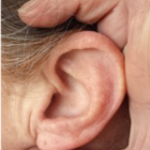Special to the Financial Independence Hub
My Google search for “choosing a financial advisor” yielded more than 30 million hits. It appears to be a popular topic. The recommendations over the first 20 pages were variations on:
Education and Experience
Compensation and potential conflicts of interest
Investment suitability to the client
Yet I propose another characteristic for consideration; one that can quickly help assess one’s risk tolerance and show whether a client and advisor are compatible.
It comes from the ancient Chinese science of Face Reading, where ears are the physical feature that shows how much innate courage and risk-taking ability a person has. The larger the ear, the more comfortable they are gambling physically, in their choice of work or taking risks with money.
To understand the kind of risk-taking you can naturally handle, all you have to do is measure the size of your ear. Measure it by holding your thumb and index finger in a “C” up to your ear. If it matches in size, you have a small ear. A large ear is the size of your thumb and middle finger formed into a “C”. A medium ear is between those two sizes.
The broader your ear is across the top, the more comfortable you are with financial and emotional risk. Chances are that you would be the type who would be more willing to try aggressive growth stocks or volatile markets for potentially larger gains.
In contrast, if your ear is narrow across the top, you’d tend to be a conservative and cautious investor. Your preference would be to invest in safer low-risk vehicles because your main goal is to preserve savings because you feel the pain of losses more intensely than the comfort of gains.
Matching to your financial advisor’s

 That’s where matchmaking our ears to our financial advisor’s gets interesting. A client with cautious, narrow ears may be most comfortable with a similarly narrow-eared, like-minded advisor. But there’s merit in matching opposite traits; a wide-eared advisor could construct a portfolio that offers protection plus opportunity for moderate growth. Or a narrow-eared advisor could help curb a high-risk tolerant client from gambling on a poorly diversified portfolio or too speculative an investment. In either case, together they could temper each other’s risk taking appetite. The main point is to know what each brings to the equation.
That’s where matchmaking our ears to our financial advisor’s gets interesting. A client with cautious, narrow ears may be most comfortable with a similarly narrow-eared, like-minded advisor. But there’s merit in matching opposite traits; a wide-eared advisor could construct a portfolio that offers protection plus opportunity for moderate growth. Or a narrow-eared advisor could help curb a high-risk tolerant client from gambling on a poorly diversified portfolio or too speculative an investment. In either case, together they could temper each other’s risk taking appetite. The main point is to know what each brings to the equation.
Unlike the risk tolerance questionnaires advisors have clients complete, our ears can be more reliable than our subjective, theoretical responses.
Case in point: the results of my assessment showed that I had a moderate to high-risk tolerance. The truth about my tolerance came to light when my portfolio dropped 17%. I was rattled. It turns out my small ears reinforced this.
There are two questions we could consider adding to the questionnaire that could provide reliable clues. Do you pay off your credit cards each month? And when driving, would you make a right turn in front of a car or wait until all cars pass? If the answers are a zero credit card balance and waiting for clear traffic, chances are you have small ears.
Every investor wants good returns but not everyone is able to handle the risk to get them. It’s knowing where you fall on the risk-taking spectrum that’s important. Ears just might provide that other missing bit of information to guide you to the decision that is right for you.
 Jane Hawley Edward worked 20 years in marketing communications management at finance, technology and public relations firms prior to opening her consulting practice in Chinese Face Reading in 2014. Apprenticed under the world’s leading authority in face reading, Lillian Pearl Bridges, Jane teaches this alternative approach for more effective communication, hiring and management in business.
Jane Hawley Edward worked 20 years in marketing communications management at finance, technology and public relations firms prior to opening her consulting practice in Chinese Face Reading in 2014. Apprenticed under the world’s leading authority in face reading, Lillian Pearl Bridges, Jane teaches this alternative approach for more effective communication, hiring and management in business.
Website: understandingfaces.com



